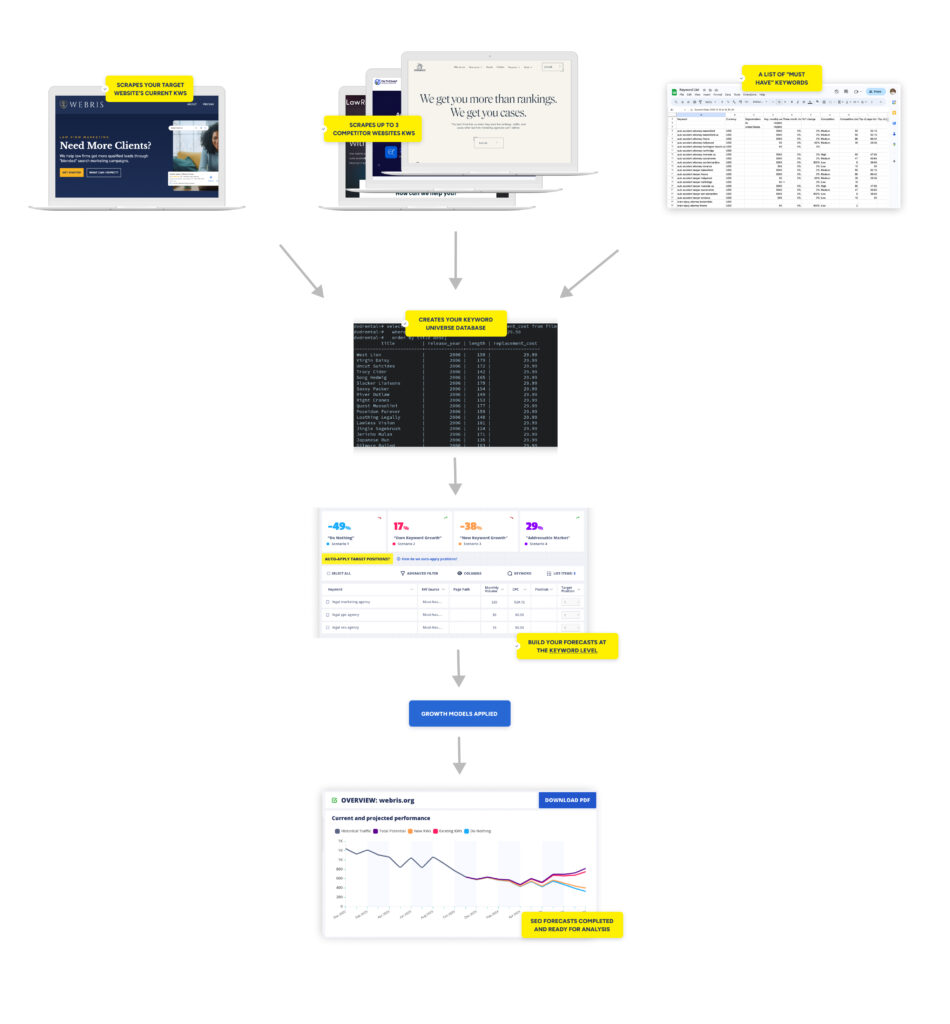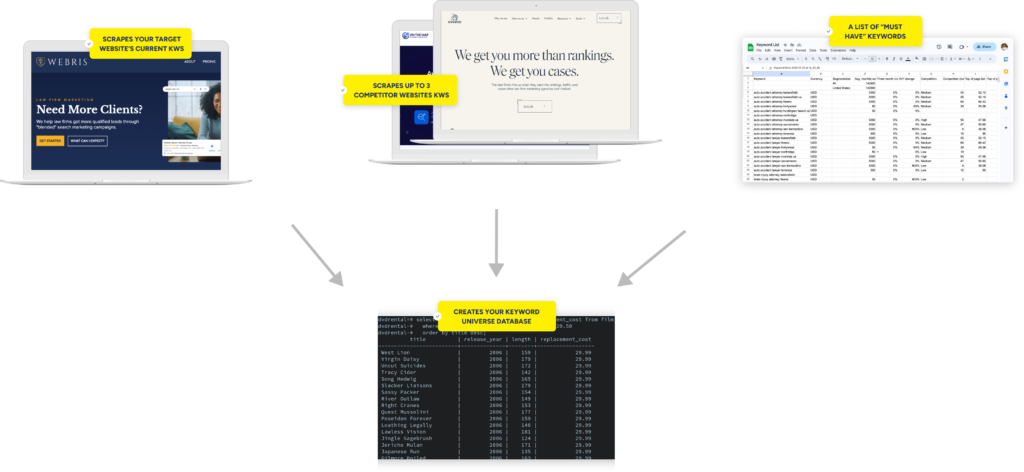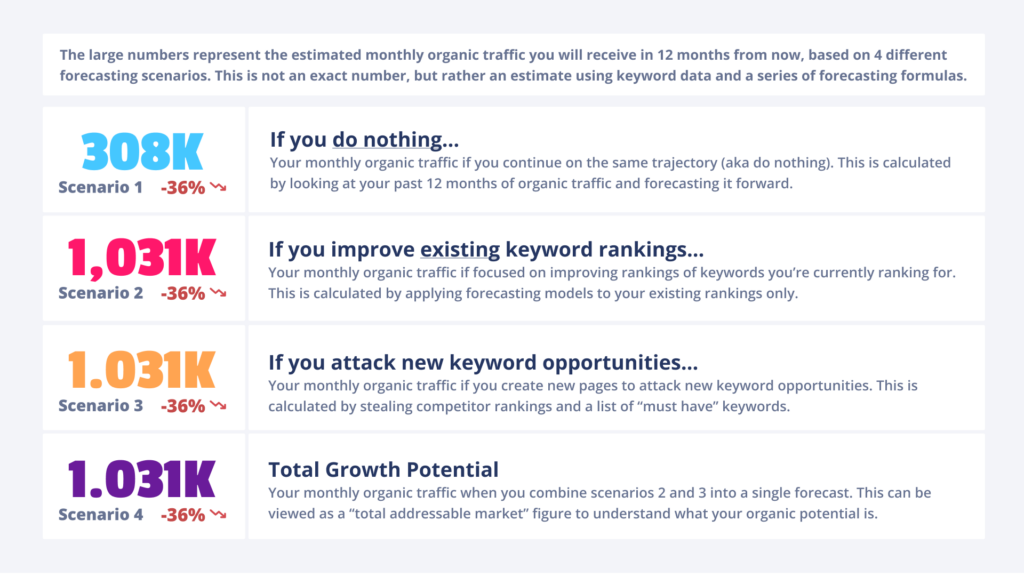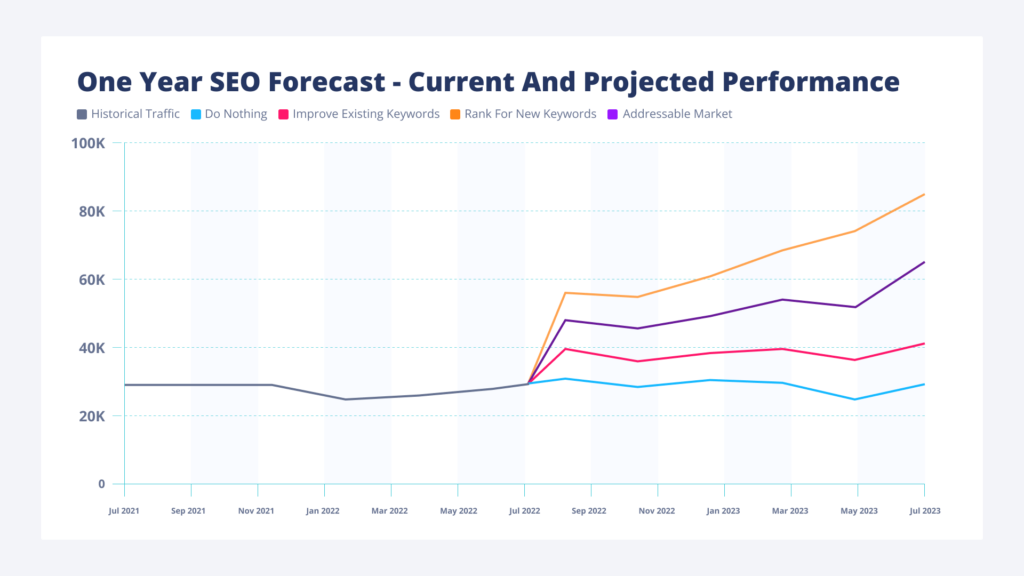Creating SEO forecasts are challenging.
We’re trying to predict how much organic traffic a website will receive from search engines, which run on the most complex set of algorithms ever created.
There’s no SEO forecasts that will ever be 100% correct. However, it is possible to build SEO forecasts that come within an acceptable deviation.
The Traffic Projection Tool creates accurate SEO forecasts in a matter of minutes because of our proprietary forecasting model.
This post will break down our forecasting model and how you can use it to project results from an SEO campaign.
Forecasting model overview
Most SEO forecasts focus on past traffic, competitors and trends to build a blanket percentage estimate.
→ “30% growth expected over the next 12 months”
This is a “Macro” analysis that get mediocre results.
Our model focuses on the “Micro” – forecasting at the keyword level. This allows for far more accurate forecasts that can be controlled based on your discretion.
The forecasting process we’ve built is as follows:
- Build a database of keywords (your keyword “universe”)
- Forecast growth for each keyword in your database
- Apply growth model to forecasts
1. Building a forecasting database
In order to create an accurate projection, we need to give the forecasting model the right dataset.
The goal is to try and find keywords that are relevant and attainable to rank for. Otherwise you will end up with forecasts that are too big and highly unlikely.
Our model gets keywords from 3 sources:
1. Your website’s current keyword rankings
These keywords are gold, especially if your target website has a good base of current performance. The tool will pick up any keywords ranking between positions 1 and 100 – that means any keyword thats in Google’s index will be added to your database.
2. Up to 3 competitor site’s keywords
If your target website doesn’t have much keyword rankings, our database will include up to 3 competitors. This feature should be used lightly – adding in the wrong competitors will inflate your keyword database (in a bad way) by including irrelevant and unattainable keywords. For example, if you operate an ecommerce website and you feed the database competitors who sell different products, you’re going to have to sift through those irrelevant keywords to exclude them.
3. A list of “must have” keywords
This is my favorite keyword source, because we can feed the model the exact keywords we want to focus on. You can add “must have” keywords to our database which ensures your database has the most valuable keywords to a campaign, especially if your website or competitors are not ranking for them.
Our tool takes these 3 sources and adds them into your database (aka keyword universe). It auto filters out any duplicates and appends each keyword with search volume, CPC, keyword intent and more valuable data.
2. Forecasting growth at the keyword level
This is where we separate ourselves from the competitors. We don’t believe in blanket forecasting, we believe in 1 on 1 forecasting. That’s why our projections are built keyword by keyword, not based on macro trends.
You assign a projection to each keyword in your forecast – you have full control over your projections.
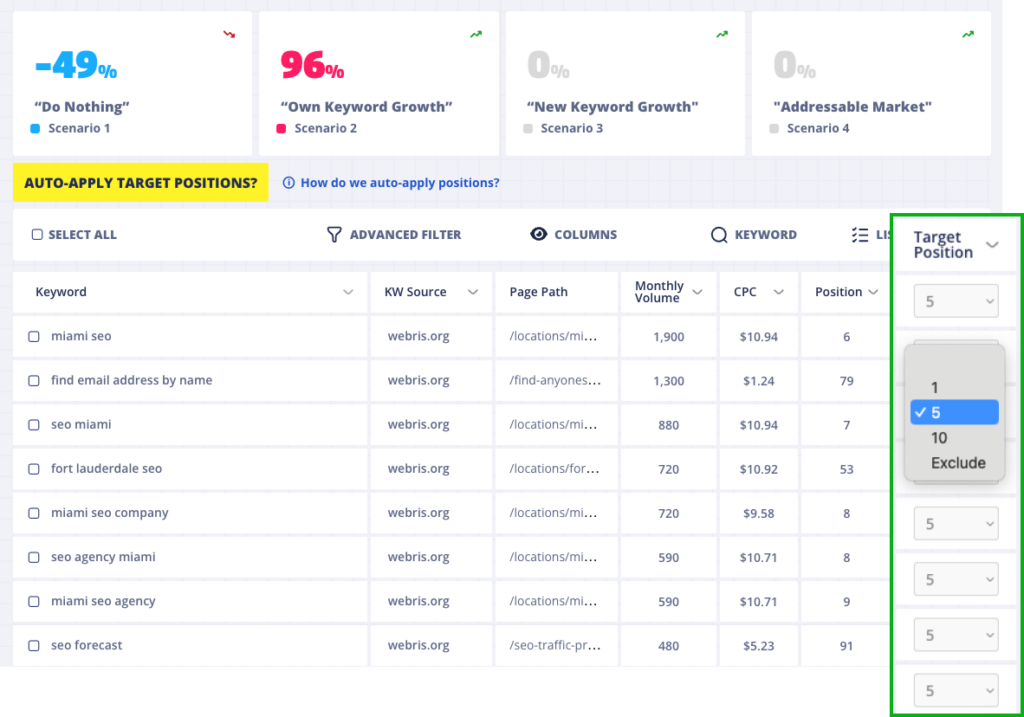
We’ve built in a number of tools to help speed up this process (including AI auto forecasting), we have plenty of articles in our help section showing how to do this.
To make this more accurate, The Traffic Projection Tool break down keyword level forecasting into 2 steps:
- Forecasting based on existing keywords
- Forecasting based on new keywords (found through competitors and “must have” keywords
This allows for more surgical forecasting because of your ability to customize based on your site’s performance and or goals.
It also makes for far better reporting – this level of forecasting results in 4 projections:
- If you do nothing
- If you improve existing keywords
- If you attack new keywords
- Total growth potential (all 3 added together)
3. Applying a growth model
After you’ve applied forecasts to your database, our growth model takes over.
Our growth model is in constant flux to keep up with Google’s ever changing algorithms and SERP features.
We take your forecasts and apply CTR data to estimate traffic:
| Google Search Feature | CTR |
| Ad Position 1 | 2.1% |
| Ad Position 2 | 1.4% |
| Ad Position 3 | 1.3% |
| Ad Position 4 | 1.2% |
| Search Position 1 | 39.8%* |
| Search Position 2 | 18.7%** |
| Search Position 3 | 10.2% |
| Search Position 4 | 7.2% |
| Search Position 5 | 5.1% |
| Search Position 6 | 4.4% |
| Search Position 7 | 3.0% |
| Search Position 8 | 2.1% |
| Search Position 9 | 1.9% |
| Search Position 10 (if present) | 1.6% |
* If snippet, then 42.9%; If local pack present, then 23.7%
** If snippet, then 27.4%; If local pack present, then 15.1%
The results
The Traffic Projection Tool presents dozens of reports, graphs and tables with your forecasting results.
Within the results, you’ll see a graph of Total Search Value by Intent. This calculation is constructed at the keyword level by using the Cost per Click (CPC) times the Projected Traffic. This result is then classified by Keyword Intent.
Its a dynamic calculation! If you adjust the Target Position of any keyword, the value will change.

SEO Forecasting Considerations
There’s a number of external factors and considerations to be accounted for when building an SEO forecast.
Getting a forecast to 100% accuracy is impossible, for a number of reasons:
- SEO is dynamic: SEO trends and algorithms are constantly evolving. What works today might not be effective tomorrow. This makes predicting exact results difficult.
- Competitor cctions: Your SEO results depend not just on your actions but also on those of your competitors. Changes in their strategies can affect your rankings.
- Keyword variables: The performance of different keywords can vary greatly. Some might yield quick results, while others take longer to show progress. Our tool does a good job of incorporating search factors and competition, but at the Macro level this is a challenge.
- Industry trends: SEO performance can also be influenced by broader industry trends and search engine updates. Staying informed about these changes is crucial.
- Google updates: While forecasts can give an idea of potential outcomes, they’re not always accurate. Unforeseen factors like algorithm updates can disrupt predictions.
Get your first forecast FREE
The Traffic Projection Tool offers industry leading SEO forecasting. If you haven’t created your account yet, email us at support@trafficprojection.com and we’ll provide you with a free trial for you to try out the tool.
